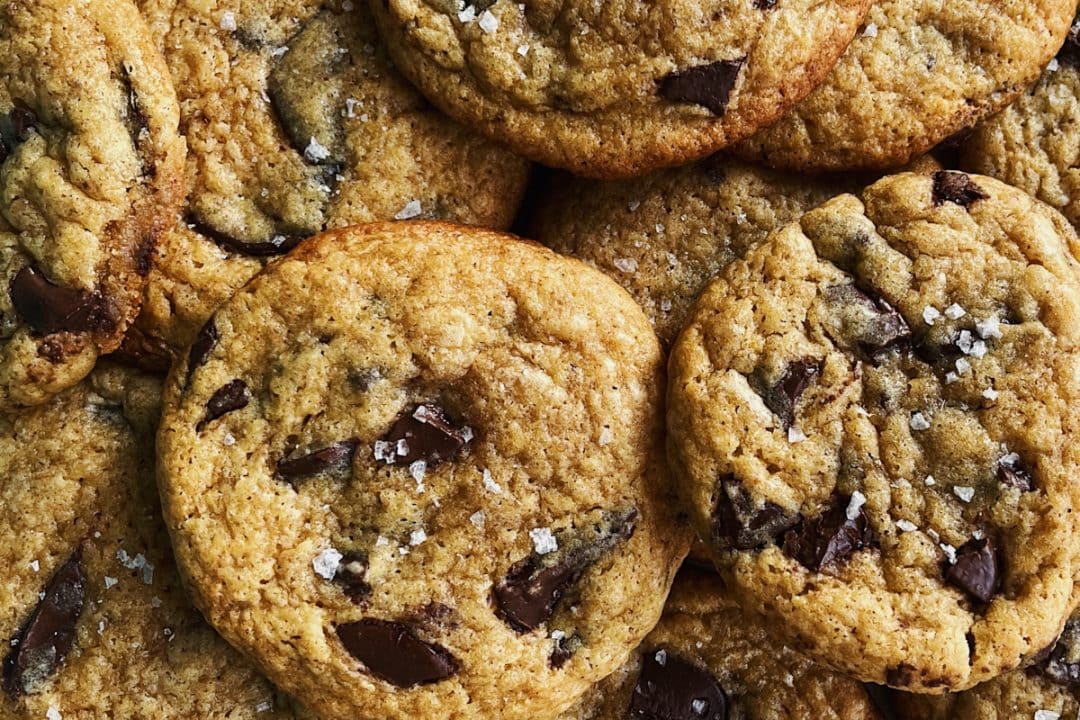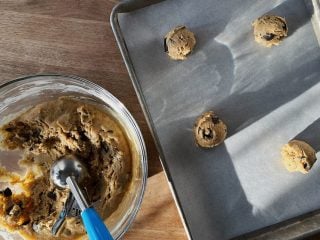Here in the U.S., we will seemingly never tire of the chocolate chip cookie. Peek into just about any bakery counter and you’ll see some iteration: thin and crisp, mounded and cakey, sometimes with fat flakes of salt showered overtop, maybe some nuts. And because the cookie is just so beloved, it feels natural that we here at The Perfect Loaf should enter a recipe into the canon. Of course, that means a sourdough chocolate chip cookie. Specifically, sourdough starter discard chocolate chip cookies. (Should we call them SSDCCCs? Whew!)
Chocolate chip cookies have been delighting Americans (formally) since 1938, when Ruth Wakefield, who ran the Toll House restaurant in Massachusetts chopped up a Nestlé semi-sweet chocolate bar and folded it into a simple vanilla cookie dough. The dough’s base is butter, sugar (typically white for spreading and tenderness, and brown for chewy denseness), eggs, vanilla, flour, some kind of chemical leavener, and chocolate chips. When reformulating it to incorporate a full cup of sourdough starter, we’ll make some adjustments to the liquid and flour, but otherwise, this recipe is pretty classic.
Eliminate Excess Water By Browning Butter and Omitting Egg White
As is the case in my recipe for sourdough starter discard sugar cookies, slowly browning 226 grams (1 cup) of butter on the stove allows some—about 20% or 40 grams, to be more specific—of its water to evaporate, leaving room to add that moisture back in via sourdough starter discard. Browning the butter also creates a lovely toasty flavor that emphasizes brown sugar’s caramel notes.
I also know that I can remove excess liquid from a cookie dough via egg whites, which are about 90% water. Perhaps you’ve noticed that many chocolate chip cookie recipes include whole eggs and an egg yolk? That extra yolk adds a little extra fat to the cookies, ultimately creating a fudgier texture (just like in these discard oatmeal raisin cookies). The resulting recipe calls for three egg yolks, but with compensating liquid from the starter to mimic two egg whites (70 grams total). That plus the water from the butter adds up officially to 115 grams liquid, or 230 grams starter discard. To make things simpler, I rounded down just a smidge to 220 grams, or 1 cup.
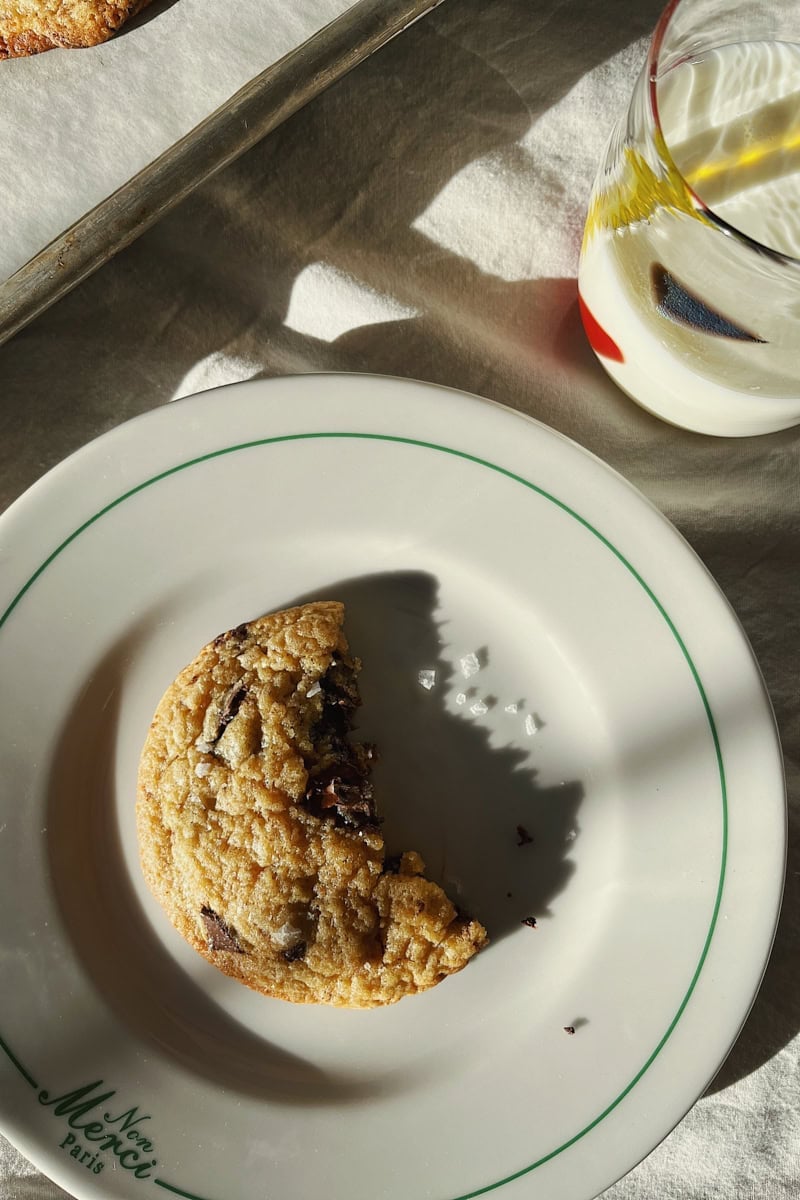
Sourdough Starter Discard Replaces Some the Removed Liquid and Some Dry Flour
With 220 grams of starter—cold from the fridge or ripe from a recent feeding—I could remove 110 grams of dry flour. A traditional cookie recipe’s bakers’ ratio dictates 3 parts flour to 2 parts fat to 1 part sugar. For a chewier cookie, a 1:1:1 ratio is recommended. I played with this a bit and I ended up with about 1 part each sugar and flour and sugar to .65 fat (butter and egg yolk). This ensured the cookie had enough structure to not spread too flat and the right amount of sweetness to offset the sourdough’s tang.
Some bakers use bread flour to get an extra-chewy cookie. If you have some and want to try it, go for it! But I say look no further than all-purpose flour. (And considering I feed my sourdough starter with AP and rye, there was no need to bring in another.) Of course, if you wanted to add a little earthiness to the cookies, you could swap in whole wheat or buckwheat flour for 25 to 50% of the dry AP.
Semisweet Chocolate Is Ideal
I typically like bittersweet (at least 70%) chocolate in my cookies, but since the sourdough starter can be quite tangy, something a little sweeter, like semisweet (60%) is perfect. Technically speaking for a chocolate chip cookie to be so-named, it should probably involve chips—but I’ll admit I used chopped chocolate for these photos.
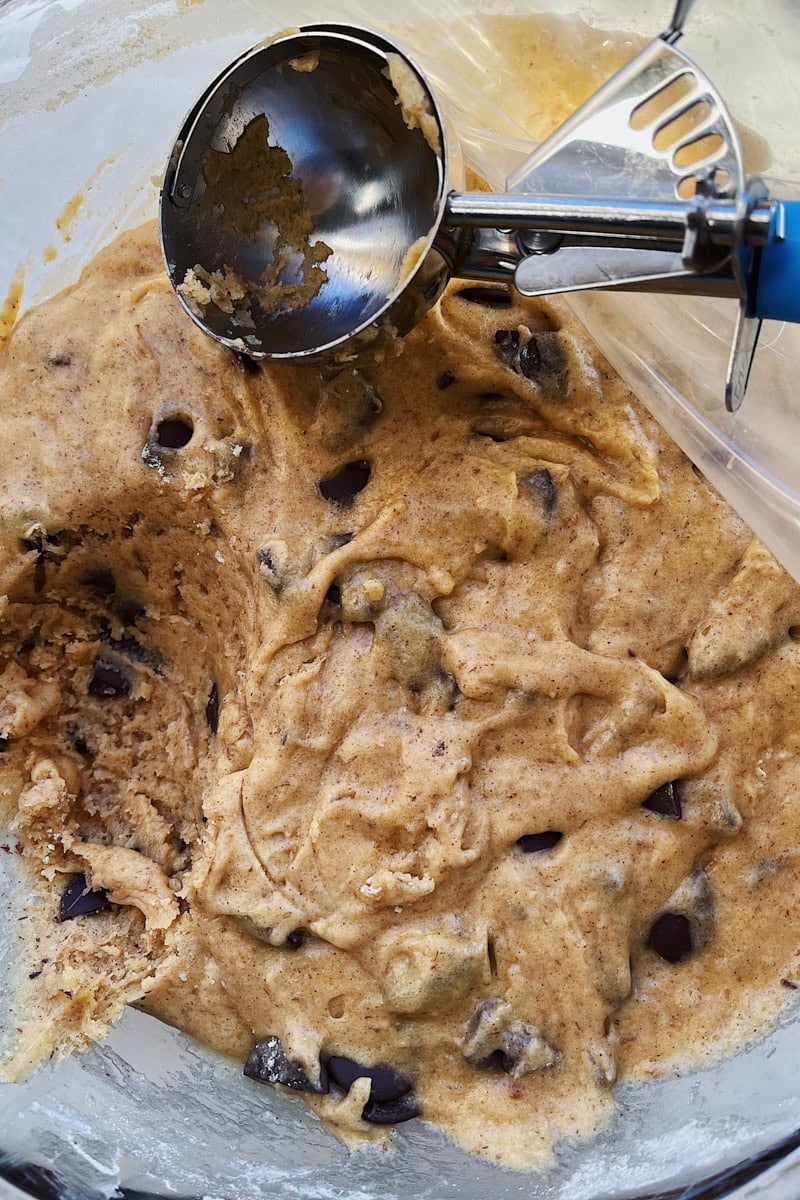
Rest the Dough For at Least an Hour for Extra Flavorful, Gooey-Centered Cookies
Resting cookie dough is a true exercise in the phrase “good things come to those who wait.” In the time the dough sits, all of the flour will fully hydrate and the melted butter will resolidify. Melted butter makes a denser, fudgy-chewy cookie (as opposed to creamed butter, which makes pillowy cookies, thanks to the air whipped in), but it can cause excess spreading. Rested, the cold fat doesn’t remelt as quickly when it hits the hot oven. These cookies have a fair amount of sugar, which also encourages spreading. You do need the sweetness to offset the tang of the starter, but resting the dough allows sugar’s hygroscopic properties to work their magic, absorbing moisture in the dough.
The time also allows for the flavors to meld a bit: Even just one hour in the fridge will yield a remarkably better-tasting cookie, but you can let them rest for up to 24 hours. The longer the rest time, the colder the dough, meaning the cookies will bake a smidge slower, and you’ll wind up with gooier centers.
Many cookie recipes encourage days of “aging” the batter. When it comes to these, the starter discard will age as well, developing a tangier flavor. Because of this, it’s best to limit the dough-resting stage to 24 hours. Waiting longer to bake? Scoop the rested dough into balls and freeze them. From there, bake the cookies as written (no need to defrost, but give them an extra few minutes in the oven).
For Picture-Perfect Cookies, Use Food Styling Tips
Ever wondered why the cookies in photos are perfectly round, with stunning flecks of chocolate studding the surface, while yours are oblong and the chocolate is lost? Two major tips I’ve learned from working in food styling can be used to diagnose both. Before baking, add a few extra pieces of chocolate to the top of each dough ball—you can hold off on mixing in 50 grams or so from the main recipe, or just add more. Either way, they’ll stay on the surface as the dough bakes.
As for perfectly round cookies, as soon as they come out of the oven, place a bowl or biscuit cutter (and keep it handy for these sourdough discard biscuits, next!) that’s slightly larger than the cookies over them and give it a little swirl, which encourages the edges to tuck in. You can also use this tip if you find the cookies weren’t placed far enough apart from each other on the pan and they’ve run into each other.
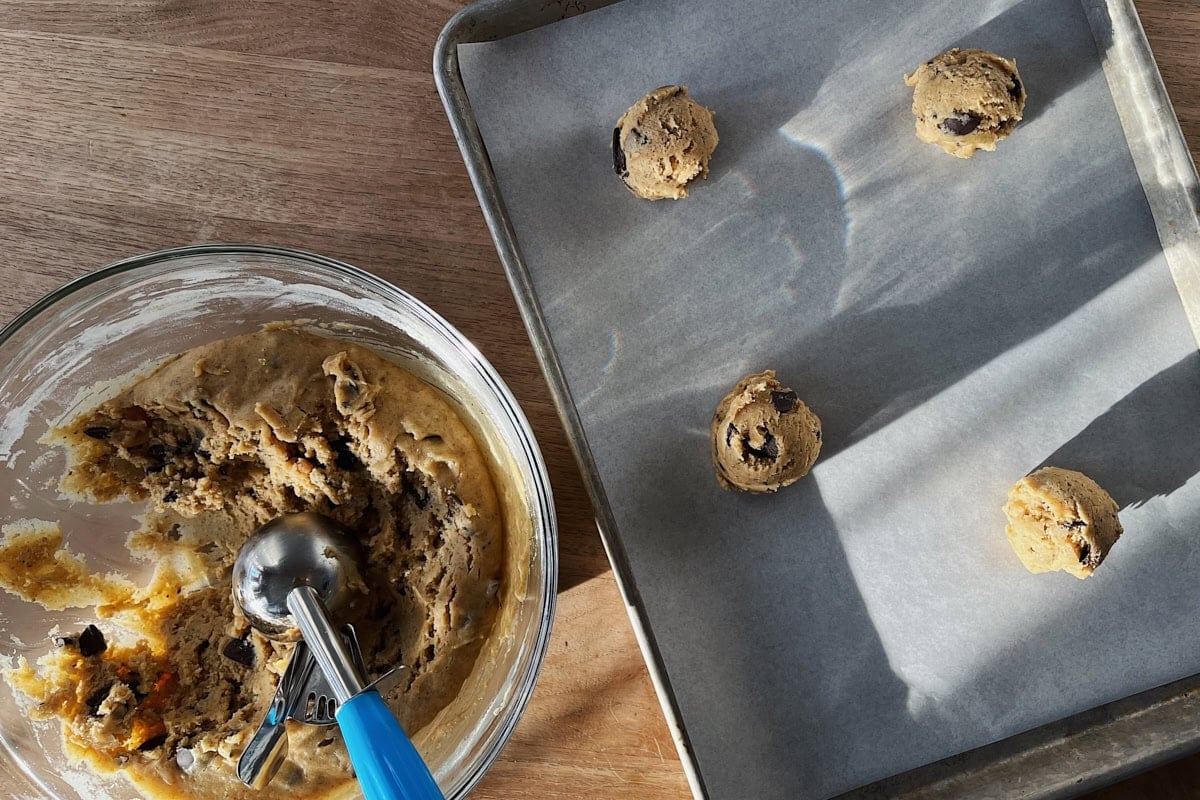
Bake Just Four Cookies Per Tray
It will seem like you can fit more than four cookie dough balls on a half sheet pan (and you can, physically.) But trust that these will bake into big (four-inch!) cookies, and to ensure they have room to spread without running into each other, four is the limit, leaving at least 3 inches of space between each dough ball. You can, however, bake two trays at a time. Follow the rules and you’ll be left with masterpieces.
Bake the Cookies Until “Medium Rare”
Baking cookies “medium-rare,” aka removing them from the oven when the centers are just barely set, leaves you with a crisp-edged, gooey-centered (when warm, or chewy-centered when cooled) cookie. They will seem like they could use a few more minutes, but if you let them cool on the sheet pan for 5 minutes before diving in, you’ll find the timing is actually perfect.
Print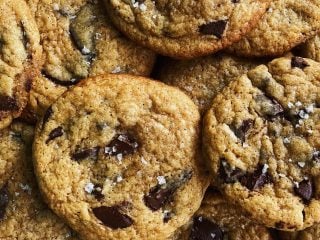
Sourdough Chocolate Chip Cookies
- Author: Rebecca Firkser
- Prep Time: 1 hour
- Cook Time: 13 minutes
- Total Time: 1 hour 13 minutes
- Yield: 19 cookies
- Category: Dessert, snack
- Cuisine: American
Description
These sourdough chocolate chip cookies cleverly incorporate discarded starter by removing excess moisture through browned butter and egg yolks, creating a perfect balance of tang and sweetness. The dough needs at least an hour of rest time to develop flavor and achieve crisp edges with a gooey center.
Ingredients
- 226 grams (1 cup, 2 sticks) unsalted butter, cut into 1-inch pieces
- 220 grams (1 cup) light brown sugar
- 100g (½ cup) granulated sugar
- 250 grams (2 cups) all-purpose flour
- 5 grams (1 teaspoon) baking powder
- 3 grams (1 teaspoon Diamond Crystal or ½ teaspoon Morton) kosher salt
- 1 grams (¼ teaspoon) baking soda
- 42 grams (3 large) egg yolks
- 9 grams (2 teaspoons) vanilla extract
- 220 grams (1 cup) sourdough starter discard (unfed, 100% hydration)
- 196 grams (7 ounces, heaping 1 cup) semisweet chocolate chips; or chopped semisweet chocolate
- Flaky sea salt, for sprinkling
Instructions
- Place the butter in a small saucepan or skillet over medium heat. Melt the butter until it starts to foam and sputter, about 3 minutes. Whisking often, continue to cook the butter until it starts to quiet down, smells nutty, and turns deeply golden brown, 5-7 minutes. As you whisk, try to lift any browning milk solids that are stuck to the pot. Remove from the heat and immediately pour into a large heatsafe bowl placed over a digital scale, making sure to scrape in as many browned bits stuck to the pan as possible. You should have about 180-190 grams butter remaining. Whisk both sugars into the hot brown butter until combined. Let the mixture cool slightly while you prep the dry ingredients.
- In a medium bowl, whisk together the flour, salt, baking powder, and baking soda.
- Whisk in the egg yolks and vanilla into the butter and sugar mixture until combined. Whisk in the sourdough discard until smooth. Switch to a spatula and fold in the flour mixture and the chocolate. Transfer the dough to the fridge to let it rest for at least 1 hour or up to 24 hours.
- When you’re ready to bake, the dough rests, preheat the oven to 375ºF (190ºC) with a rack in the upper and lower third, and line two sheet pans with parchment paper.
- Use a #16 (2-ounce; ¼-cup) cookie scoop to portion out mounds of dough (each should weigh about 70 grams). Roll each mound into a ball and then arrange 4 balls evenly on each sheet pan. It will seem like you could fit more: don’t be tempted! These are big cookies and they spread—make sure there’s at least 3 inches of space between each dough ball. Store remaining dough balls in the fridge until you’re ready to bake.
- Bake two pan of cookies at the same time, swapping oven racks halfway through baking, until the cookies are golden and set at the edges and slightly matte and barely set in the center, 11 to 13 minutes. If the bottom or top of your oven runs hotter, check that tray of cookies at the earliest finish mark. They may look quite puffy at this point, but will settle into wrinkles as they cool. Remove from the oven and sprinkle with flaky salt. Let cool on the sheet pans for 5 minutes before eating or transferring to cooling racks. Store leftovers in an airtight container at room temperature for up to 1 week.
Can I Use Chopped Chocolate Instead of Chocolate Chips?
Yes! Chips are classic, but I actually think chopped chocolate looks nicer. Use what you have!
Can I Skip Resting the Cookie Dough?
I wouldn’t! There are real reasons to rest the dough (see above), all of which will yield a better cookie. It’s important to rest the dough for at least 1 hour before baking. Feed your starter, clean up the kitchen, preheat the oven, and you’ll find the time speeds by.
How Do I Get Perfectly Round Cookies?
For the most perfectly round cookies, place a bowl or biscuit cutter that’s slightly larger than the cookies over each finished cookie and swirl a few times.
Can I Freeze the Dough And Bake Cookies Later?
Yes! One of life’s great pleasures is cookie dough in the freezer. After resting the dough for 1 or up to 24 hours, scoop the dough into balls. Place them (without touching, but they can be snug) on a parchment-lined sheet pan and freeze until solid, about 2 hours. Transfer to an airtight container and freeze for up to 6 months. When you’re ready for a cookie, bake as directed, giving them a couple more minutes in the oven as needed to hit the visual indicators.
Can I Make These Cookies Smaller?
Yes! Form 50-gram balls of dough and bake 6 to a sheet pan, evenly spaced apart. Start checking them for doneness at 9 minutes. Making smaller cookies also means the total yield will be higher—we all know that more cookies is never a bad thing.
What’s Next?
In the mood for more cookies? Check out these discard sugar cookies or even oatmeal raisin cookies.
Or, see our collection of sourdough starter discard recipes for more ways to put that starter discard to use.


